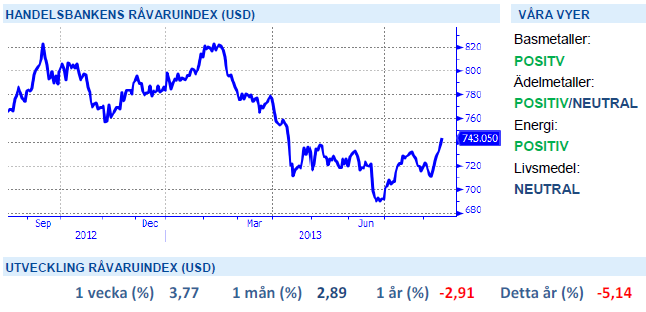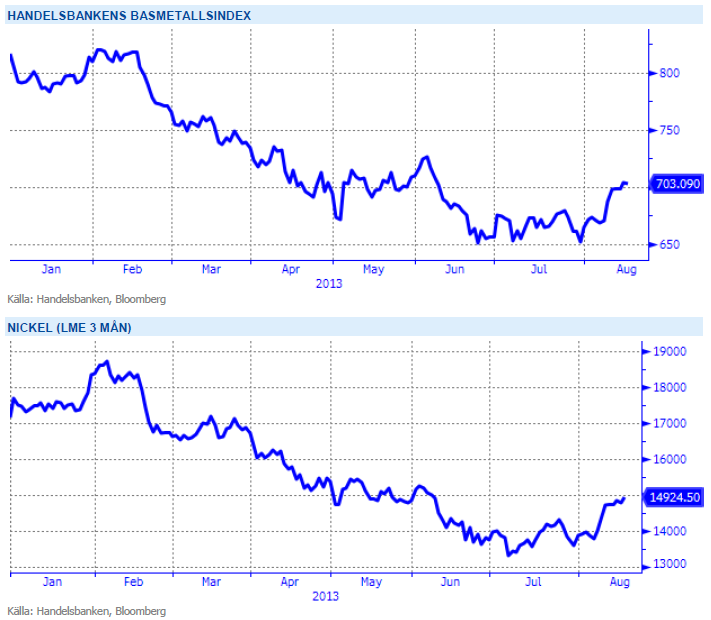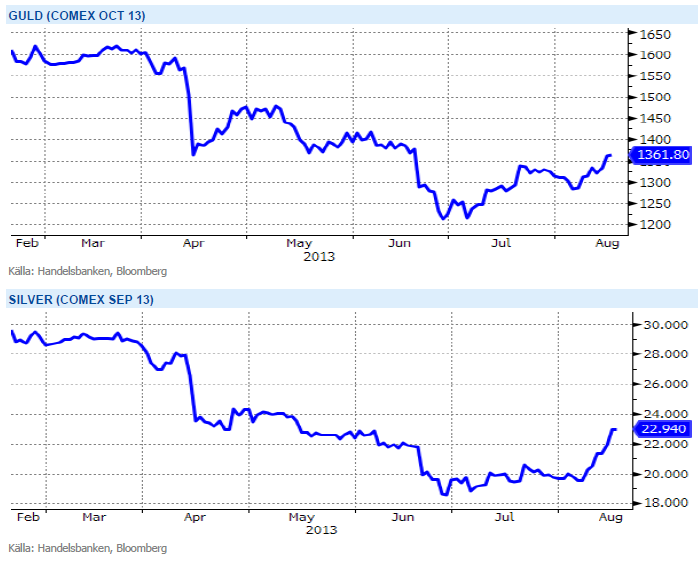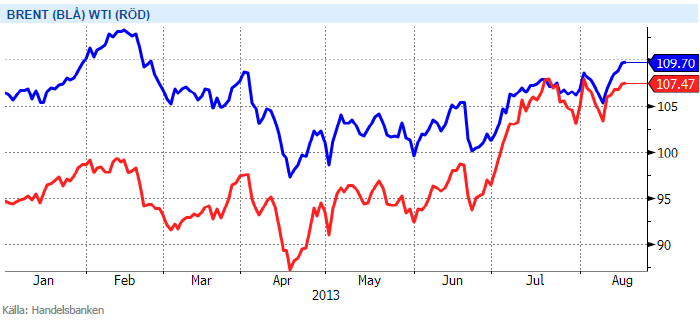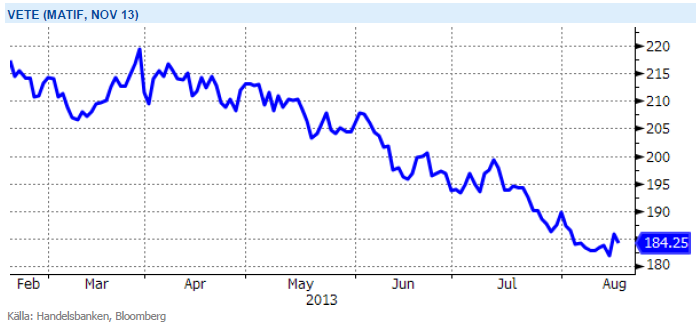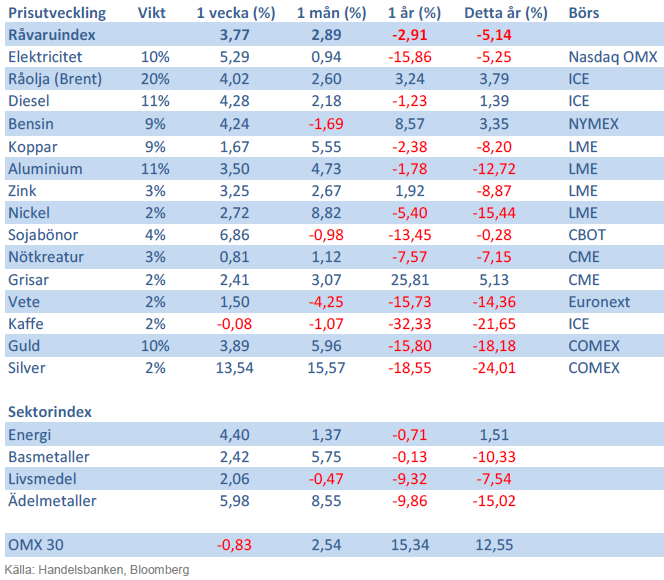Analys
SHB Råvarubrevet 16 augusti 2013

 Råvaror allmänt
Råvaror allmänt
Back to School
Efter sköna lata dagar är de flesta tillbaka på arbetsplatsen och fokus ligger åter på ekonomisk data och aktuella teman för hösten. Tre teman kommer dominera prisutvecklingen för industriråvaror under andra halvåret: Eurozonen, Fed och Kina. En glad överraskning efter sommaren var att Eurozonen hoppade upp ur recessionsträsket. 0,3 % tillväxt under Q2 är såklart välkommet som bidrag till globala tillväxten. Visserligen kommer inte positiv tillväxt i Eurozonen, skapad av Tyskland och Frankrike, att lösa de djupt rotade problemen i de perifera länderna i Europa, de kan till och med bli en negativ effekt spunnen ur den starkare eurokursen som kommer av starka kärnländer, men givet rådande låga förväntningar på EMU så tror vi att EMU data har potential att driva prisuppgångar framöver. Sammanfattningsvis är recensionen över medan skuldkrisen lever.
Om Eurozonen är marginellt bättre så kompenseras det av Feds påbörjan av att minska sitt bidrag till marknaden. Antagligen redan i september men i kombination med löften om att hålla räntorna låga mycket längre. Därför tror vi att ”tapering” endast får liten negativ inverkan på råvarupriser. Temat har varit känt sedan maj, övriga centralbanker är fortfarande expansiva och Fed väntas enbart trimma sina stödköp om USA:s ekonomi fortsätter att stärkas.
Om vi antar att dessa båda teman balanserar varandra (om än med övervikt åt positiv EMU effekt) så återstår Kina som det osäkra kortet. Senaste omgången med data var klart bättre än väntat. Handelsdata och råvaruimport var klarast lysande stjärnor. Råvaruimporten av de fyra stora, järnmalm, olja, koppar och sojabönor var den högsta på ett år. Ett sammanträffande som säger något då dessa råvaror används i vitt skilda sektorer. Uppgången har drivits av ökade investeringar och ökad kreditgivning tidigare i år. För råvarornas del tror vi att det handlar om en klassik ”restocking” där lagerkedjan är på mycket låga nivåer efter besvärliga tider och åtstramade krediter i Kina. Vårt argument för att det inte rör sig om en ökad slutkonsumtion är främst industri PMI som hovrar omkring 50-strecket. Icke desto mindre kan lagerrörelsen driva industriråvaror under en månad eller två.
Basmetaller
Kina stärker metallerna
Kinas ekonomi har tappat fart under 9 av de 10 senaste kvartalen. Efter en serie av små förändringar från beslutsfattare så har trenden (åtminstone tillfälligt) vänt. Under juli steg industriproduktion, investeringar och bostadsbyggande. De är de viktigaste kategorierna för basmetaller som följaktligen också har stigit i pris. Vårt basmetallindex steg med 6 % under första halvan av augusti där samtliga basmetaller har stärkts med 6-8 %.
Extra bränsle fick brasan av en urstark kinesisk råvaruimport. Denna är visserligen laggad då det tar 6 veckor att skeppa koppar från Chile och järnmalm och sojabönor från Brasilien till Kina men att importen var upp bland vitt skilda råvaror är ett styrketecken. Basmetaller har varit hårt nedtryckta av korta positioner och med en starkare dataström från Kina så ska många korta positioner ut ur LME metallerna. Vi tror på stigande basmetaller med nickel som favorit.
Nickel är den basmetall som gått ner mest under året och med många gruvor som går med förlust på dagens prisnivåer tror vi på stigande priser. Vi tror på: LONG NICKEL H
Ädelmetaller
Guldet fortsatt starkt
Den 1 juli presenterade vi ett kortsiktigt köpcase på guld, baserat på att priset då rasat väldigt mycket på kort tid, på att kvartalsskiftet orsakade extra stora försäljningar, och på att inflationsförväntningarna börjat stiga igen. Vidare såg guldet rent tekniskt ut att vara översålt. Sedan dess har guldet gått från 1240 dollar per uns till nuvarande 1360 dollar, en uppgång på ca.10 procent. Vi tror att uppgången har lite mer att hämta, även om vi alltjämt håller i vår mer långsiktigt negativa vy.
Den nuvarande drivkraften är primärt den tragiska utvecklingen i Egypten som skapar riskaversion och flykt till mer upplevt säkra tillgångar som guld. Det är dock viktigt att ”dansa nära nödutgången” när man handlar mot sin långsiktiga vy, så vi måste vara påpassliga för plötsliga prisfall orsakade av bättre riskaptit eller fallande inflationsförväntningar. Vi ser fortfarande 1450 som en rimlig nivå att nå i denna uppåtrörelse.
I ett läge där råvaror generellt har viktats ned av institutionella placerare kan guld och silver få en ”omotiverad” uppgång när dessa indexköpare återvänder till råvaror drivit av bättre utsikter för Kina och USA. Vi tror på : LONG GULD H och LONG SILVER H
Energi
Dyrare olja i sommar
Stigande WTI olja och efterföljande Brent har dragit rubriker i sommar. För WTI handlar det mest om att logistiska knutar har lösts upp i USA och ökat utflödet från Cushing som är leveranspunkten för WTI. Lägre lager som sammanföll med stark bensinefterfrågan under driving season stärkte också priset. Brentoljan har också stigit, drivit av högre WTI och oroligheterna i Egypten/ Mellanöstern. Egypten i sig är inget stort oljeland men som stor ekonomi viktig för regionens (in)stabilitet. Presidentbyte i Iran har ännu inte lett till förändrad kommunikation kring sanktionerna. Rouhani är dock mer västvänlig än sin föregångare. I dagsläget är utbudstörningar i Irak mer prisdrivande. Ökat våld och politiskt vakuum har fått produktionsutsikterna på fall. Irak är idag OPEC:s näst största medlem sedan sanktionerna mot Iran infördes. Saudi har redan växlat upp produktionen för att kompensera vilket fått ner Brent något. Saudis roll är alltså inte över trots den boomande oljeproduktionen i USA.
Den korta elpriskurvan stärktes tillfälligt under sommaren med närmare 6 procent vilket främst orsakades av torrt väder och stigande kolpriser. Den hydrologiska balansen försämrades från -6 TWh till -11Twh för att sedan åter falla tillbaka till -6 TWh samtidigt som den negativa trenden på kolmarknaden fortsätter. Såväl gas som utsläppsrätterna handlas i stort sett oförändrat över sommaren samtidigt som spotpriserna i Norden kommer in på stabila nivåer, ca 30 öre per kWh i snitt sedan 1 juni och 33.5 öre i snitt hittills i år. Utsikterna framöver pekar på ett torrare scenario mot normalt vilket i kombination med något starkare kontinentala marknader bör ge fortsatt stöd i en semesterlugn elmarknad.
Utsikterna framöver pekar på ett torrare scenario mot normalt vilket i kombination med något starkare kontinentala marknader bör ge fortsatt stöd. Vi tror på: LONG EL
Livsmedel
Goda skördar pressar priset
Priserna på de stora jordbruksgrödorna vete, majs och soja har fallit kraftigt under sommaren. I april skrev vi om ett lägre pris på vete framtill hösten på 15-18%, det har sedan dess fallit 15 % och därmed har vi sett det stora fall vi förväntade oss. Det finns fortfarande kvar risk på nedsidan men det kan vara dags att ta hem vinst för korta positioner. Anledningen till prisrasen är främst en generellt sett gynnsam utveckling för grödorna i flera viktiga odlingsområden. Majsen och sojan i USA fick en dålig och sen start men har därefter upplevt en ganska lång period av nära idealiska förhållanden. Förväntningarna på kommande skörd har med tiden skrivits upp flera gånger – det samtidigt som tiden för eventuella bakslag hela tiden minskat. Efter de stora prisfallen har priset på vete, majs och soja neutraliserats men vi ser fortsatt risk på nedsidan – om än mindre än tidigare.
För kakao har uteblivet regn och torka har ökat risken för minskad skörd i Elfenbenskusten, vilket har pressat upp priset till två års högsta. Vi ser också signaler på stigande konsumtion i tillväxtländerna och står därför kvar vid vår vy om fortsatt stigande kakaopris.
I många kaffeproducerande länder däremot, med Brasilien i spetsen, har det regnat i mängder under odlingsperioden och det råder viss oro kring kvalitén på kaffebönorna nu när vi går mot senare delen av skördeperioden. Förseningen har lett till att en del odlare sålt sin skörd till reducerade priser. Förutom nederbörden i Brasilien och fortsatta problem i Centralamerika och Mexico med svampsjukdomar väntas världsproduktionen på kaffe för säsongen 2013/-14 komma att minsta med 3 procent medan en blygsam ökning väntas på konsumtionssidan. Med andra ord så finns det än så länge gott om kaffe på marknaden varför vi tror på terminspris (frontkontrakt) under 1,25 dollar/Ib.
Sammanfattningsvis håller vi en neutral för vårt livsmedelsindex.
Handelsbankens råvaruindex
[box]SHB Råvarubrevet är producerat av Handelsbanken och publiceras i samarbete och med tillstånd på Råvarumarknaden.se[/box]
Ansvarsbegränsning
Detta material är producerat av Svenska Handelsbanken AB (publ) i fortsättningen kallad Handelsbanken. De som arbetar med innehållet är inte analytiker och materialet är inte oberoende investeringsanalys. Innehållet är uteslutande avsett för kunder i Sverige. Syftet är att ge en allmän information till Handelsbankens kunder och utgör inte ett personligt investeringsråd eller en personlig rekommendation. Informationen ska inte ensamt utgöra underlag för investeringsbeslut. Kunder bör inhämta råd från sina rådgivare och basera sina investeringsbeslut utifrån egen erfarenhet.
Informationen i materialet kan ändras och också avvika från de åsikter som uttrycks i oberoende investeringsanalyser från Handelsbanken. Informationen grundar sig på allmänt tillgänglig information och är hämtad från källor som bedöms som tillförlitliga, men riktigheten kan inte garanteras och informationen kan vara ofullständig eller nedkortad. Ingen del av förslaget får reproduceras eller distribueras till någon annan person utan att Handelsbanken dessförinnan lämnat sitt skriftliga medgivande. Handelsbanken ansvarar inte för att materialet används på ett sätt som strider mot förbudet mot vidarebefordran eller offentliggörs i strid med bankens regler.
Analys
Brent crude inching higher on optimism that US inflationary pressures are fading


Brent crude price inching higher on optimistic that US inflationary pressures are fading. Brent crude closed up 1.1 USD/b ydy to a close of USD 86.39/b which was the highest close since the end of April. This morning it is trading up another half percent to USD 86.9/b along with comparable gains in industrial metals and Asian equities. At 14:30 CET the US will publish its preferred inflation gauge, the PCE figure. Recent data showed softer US personal spending in Q1. Expectations are now high that the PCE inflation number for May will show fading inflationary pressures in the US economy thus lifting the probability for rate cuts later this year which of course is positive for the economy and markets in general and thus positive for oil demand and oil prices. Hopes are high for sure.
Brent crude is trading at the highest since the end of April
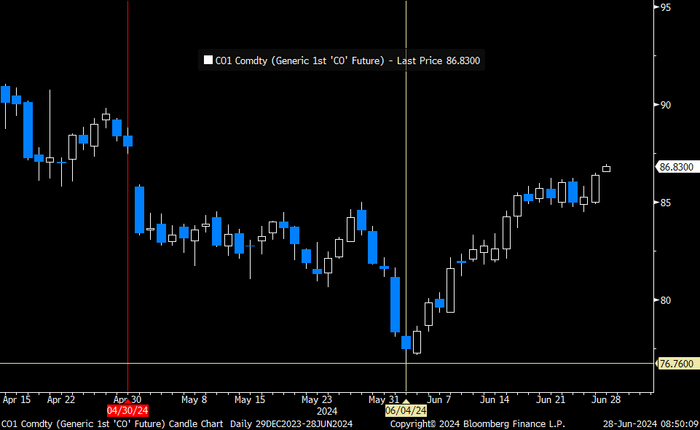
The rally in Brent crude since early June is counter to rising US oil inventories and as such a bit puzzling to the market.
US commercial crude and oil product stocks excluding SPR.
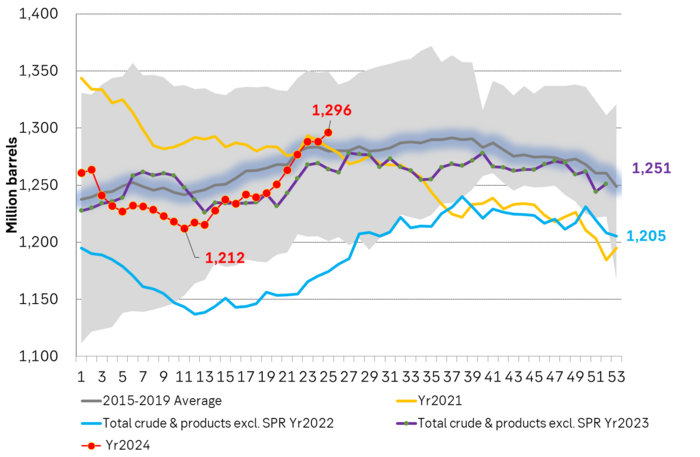
Actual US crude oil production data for April will be published later today. Zero growth in April is likely. Later today the US EIA will publish actual production data for US crude and liquids production for April. Estimates based on US DPR and DUC data indicates that there will indeed be zero growth in US crude oil production MoM in April. This will likely driving home the message that there is no growth in US crude oil production despite a Brent crude oil price of USD 83/b over the past 12 mths. The extension of this is of course rising expectations that there will be no growth in US crude oil production for the coming 12 months either as long as Brent crude hoovers around USD 85/b.
US production breaking a pattern since Jan 2014. No growth at USD 83/b. What stands out when graphing crude oil prices versus growth/decline in US crude oil production is that since January 2014 we have not seen a single month that US crude oil production is steady state or declining when the Brent crude oil price has been averaging USD 70.5/b or higher.
US Senate looking into the possibility that US shale oil producers are now colluding by holding back on investments, thus helping to keep prices leveled around USD 85/b.
Brent crude 12mth rolling average price vs 4mth/4mth change in US crude oil production. Scatter plot of data starting Jan 2014. Large red dot is if there is no change in US crude oil production from March to April. Orange dots are data since Jan 2023. The dot with ”-1.3%” is the March data point.
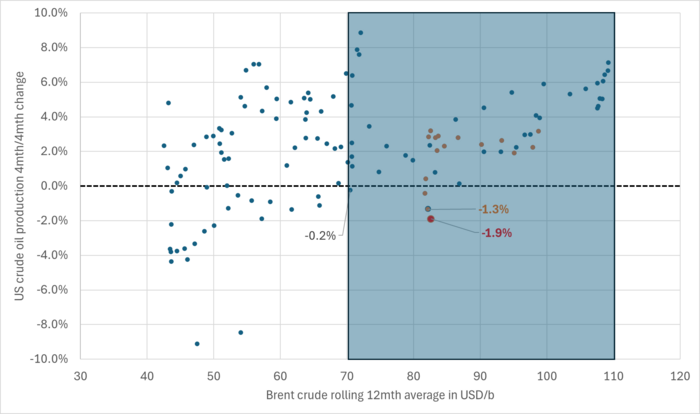
Brent crude 12mth rolling average price vs 4mth/4mth change in US crude oil production. Data starting Jan 2014. The last data point is if there is no change in US crude oil production from March to April.
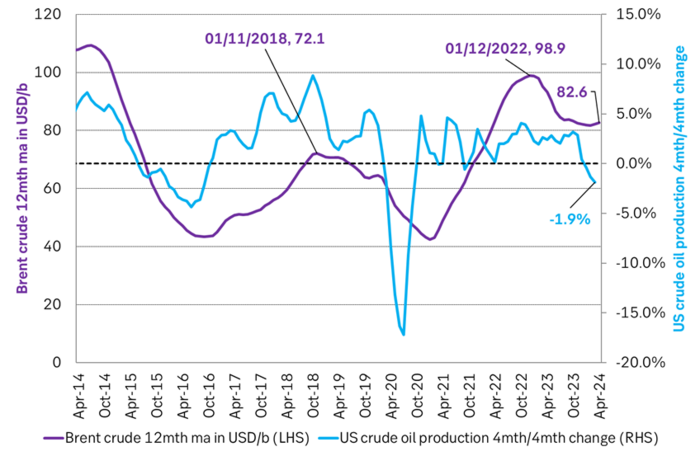
Analys
Price forecast update: Weaker green forces in the EU Parliament implies softer EUA prices


We reduce our forecast for EUA prices to 2030 by 10% to reflect the weakened green political agenda in the EU Parliament following the election for the Parliament on 6-9 June. The upcoming election in France on 7 July is an additional risk to the political stability of EU and thus in part also to the solidity of the blocks green agenda. Environmental targets for 2035 and 2040 are most at risk of being weakened on the margin. EUA prices for the coming years to 2030 relate to post-2030 EUA prices through the bankability mechanism. Lower post-2030 climate ambitions and lower post-2030 EUA prices thus have a bearish impact on EUA prices running up to 2030. Actual softening of post-2030 climate ambitions by the EU Parliament have yet to materialize. But when/if they do, a more specific analysis for the consequences for prices can be carried out.
EUA prices broke with its relationship with nat gas prices following the EU Parliament election. The EUA price has dutifully followed the TTF nat gas price higher since they both bottomed out on 23 Feb this year. The EUA front-month price bottomed out with a closing price of EUR 50.63/ton on 23 Feb. It then reached a recent peak of EUR 74.66/ton on 21 May as nat gas prices spiked. Strong relationship between EUA prices and nat gas prices all the way. Then came the EU Parliament election on 6-9 June. Since then the EUA price and TTF nat gas prices have started to depart. Bullish nat gas prices are no longer a simple predictor for bullish EUA prices.
The front-month EUA price vs the front-year TTF nat gas price. Hand in hand until the latest EU Parliament election. Then departing.
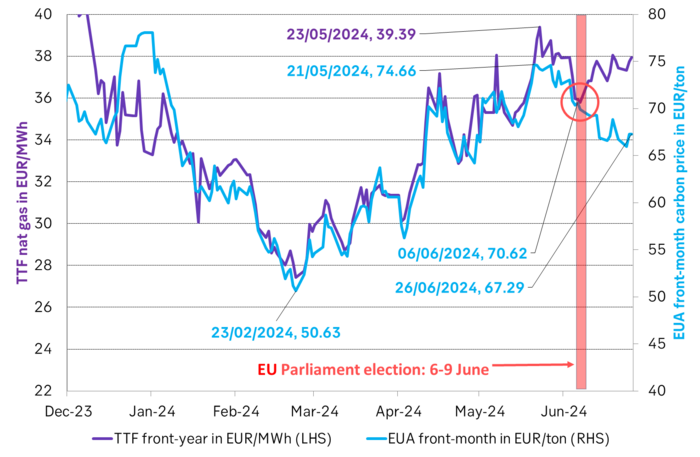
The EU Parliament election on 6-9 June was a big backlash for the Greens. The Greens experienced an euphoric victory in the 2019 election when they moved from 52 seats to 74 seats in the Parliament. Since then we have had an energy crisis with astronomic power and nat gas prices, rampant inflation and angry consumers being hurt by it all. In the recent election the Greens in the EU Parliament fell back to 53 seats. Close to where they were before 2019.
While green politics and CO2 prices may have gotten a lot of blame for the pain from energy prices over the latest 2-3 years, the explosion in nat gas prices are largely to blame. But German green policies to replace gas and oil heaters with heat pumps and new environmental regulations for EU farmers are also to blame for the recent pullback in green seats in the Parliament.
Green deal is still alive, but it may not be fully kicking any more. Existing Green laws may be hard to undo, but targets for 2035 and 2040 will be decided upon over the coming five years and will likely be weakened.
At heart the EU ETS system is a political system. As such the EUA price is a politically set price. It rests on the political consensus for environmental priorities on aggregate in EU.
The changes to the EU Parliament will likely weaken post-2030 environmental targets. The changes to the EU Parliament may not change the supply/demand balance for EUAs from now to 2030. But it will likely weaken post-2030 environmental targets and and thus projected EU ETS balances and EUA prices post-2030. And through the bankability mechanism this will necessarily impact EUA prices for the years from now to 2030.
Weaker post-2030 ambitions, targets and prices implies weaker EUA prices to 2030. EUA prices are ”bankable”. You can buy them today and hold on to them and sell them in 2030 or 2035. The value of an EUA today fundamentally rests on expected EUA prices for 2030/35. These again depends on EU green policies for the post 2030 period. Much of these policies will be ironed out and decided over the coming five years.
Weakening of post-2030 targets have yet to materialize. But just talking about it is a cold shower for EUAs. These likely coming weakenings in post-2030 environmental targets and how they will impact EUA prices post 2030 and thus EUA prices from now to 2030 are hard to quantify. But what is clear to say is that when politicians shift their priorities away from the environment and reduce their ambitions for environmental targets post-2030 it’s like a cold shower for EUA prices already today.
On top of this we now also have snap elections in the UK on 4 July and in France on 7 July with the latter having the potential to ”trigger the next euro crisis” according to Gideon Rachman in a recent article in FT.
What’s to be considered a fair outlook for EUA prices for the coming five years in this new political landscape with fundamentally changed political priorities remains to be settled. But that EUA price outlooks will be lowered versus previous forecasts is almost certain.
We reduce our EUA price forecast to 2030 by 10% to reflect the new political realities. To start with we reduce our EUA price outlook by 10% from 2025 to 2030 to reflect the weakened Green agenda in the EU parliament.
SEB’s EUA price forecast, BNEF price forecasts and current market prices in EUR/MWh
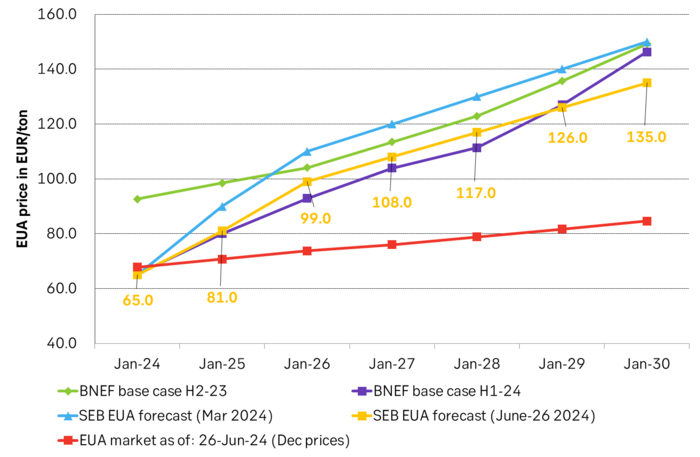
Analys
The most important data point in the global oil market will be published on Friday 28 June


US crude oil production has been booming for more than a decade. Interrupted by two setbacks in response to sharp price declines. The US boom has created large waves in the global oil market and made life very difficult for OPEC(+). Brent crude has not traded below USD 70/b since Dec-2021 and over the past year, it has averaged USD 84/b. US shale oil production would typically boom with such a price level historically. However, there has been zero growth in US crude oil production from Sep-2023 to Mar-2024. This may be partially due to a cold US winter, but something fundamentally seems to have changed. We recently visited a range of US E&P and oil services companies in Houston. The general view was that there would be zero growth in US crude oil production YoY to May 2025. If so and if it also is a general shift to sideways US crude oil production beyond that point, it will be a tremendous shift for the global oil market. It will massively improve the position of OPEC+. It will also sharply change our perception of the forever booming US shale oil supply. But ”the proof is in the pudding” and that is data. More specifically the US monthly, controlled oil production data is to be published on Friday 28 June.
The most important data point in the global oil market will be published on Friday 28 June. The US EIA will then publish its monthly revised and controlled oil production data for April. Following years of booming growth, the US crude oil production has now gone sideways from September 2023 to March 2024. Is this a temporary blip in the growth curve due to a hard and cold US winter or is it the early signs of a huge, fundamental shift where US crude oil production moves from a decade of booming growth to flat-lining horizontal production?
We recently visited a range of E&P and oil services companies in Houston. The general view there was that US crude oil production will be no higher in May 2025 than it is in May 2024. I.e. zero growth.
It may sound undramatic, but if it plays out it is a huge change for the global oil market. It will significantly strengthen the position of OPEC+ and its ability to steer the oil price to a suitable level of its choosing.
The data point on Friday will tell us more about whether the companies we met are correct in their assessment of non-growth in the coming 12 months or whether production growth will accelerate yet again following a slowdown during winter.
The US releases weekly estimates for its crude oil production but these are rough, temporary estimates. The market was fooled by these weekly numbers last year when the weekly numbers pointed to a steady production of around 12.2 m b/d from March to July while actual monthly data, with a substantial lag in publishing, showed that production was rising strongly.
The real data are the monthly, controlled data. These data will be the ”proof of the pudding” of whether US shale oil production now is about to shift from a decade of booming growth to instead flat-line sideways or whether it will drift gradually higher as projected by the US EIA in its latest Short-Term Energy Outlook.
US crude oil production given by weekly data and monthly data. Note that the monthly, controlled data comes with a significant lag. The market was thus navigating along the weekly data which showed ”sideways at 12.2 m b/d” for a significant period last year until actual data showed otherwise with a time-lag.
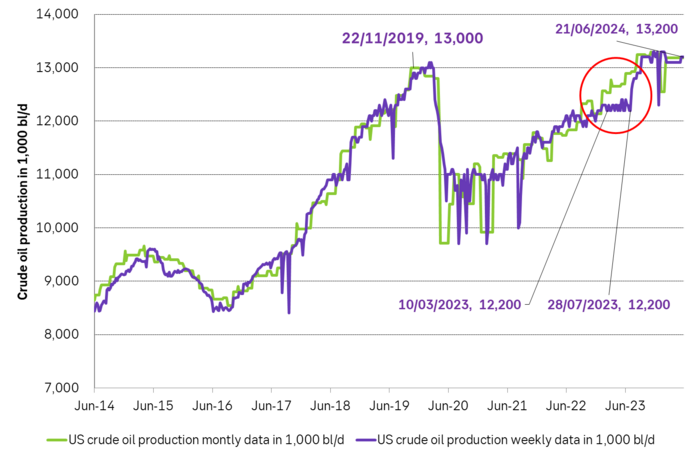
If we add in Natural Gas Liquids and zoom out to include history back to 2001 we see an almost uninterrupted boom in supply since Sep 2011 with a few setbacks. At first glance, this graph gives little support to a belief that US crude oil production now suddenly will go sideways. Simple extrapolation of the graph indicates growth, growth, growth.
US crude and liquids production has boomed since September 2011
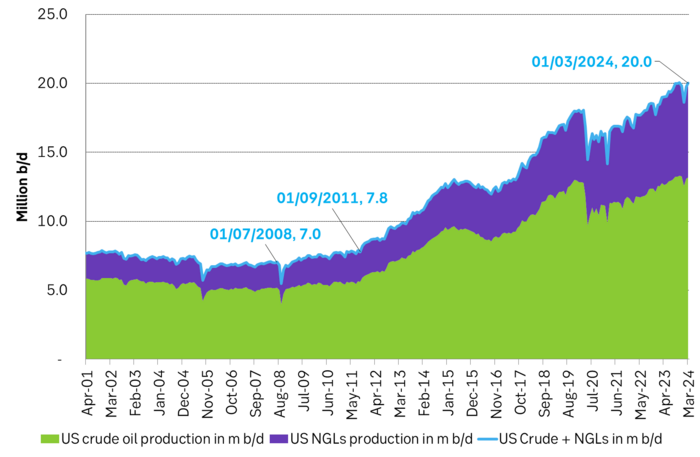
However. The latest actual data point for US crude oil production is for March with a reading of 13.18 m b/d. What stands out is that production then was still below the September level of 13.25 m b/d.
The world has gotten used to forever growing US crude oil production due to the US shale oil revolution, with shorter periods of sharp production declines as a result of sharp price declines.
But the Brent crude oil price hasn’t collapsed. Instead, it is trading solidly in the range of USD 70-80-90/b. The front-month Brent crude oil contract hasn’t closed below USD 70/b since December 2021.
Experiences from the last 15 years would imply wild production growth and activity in US shale oil production at current crude oil prices. But US crude oil production has now basically gone sideways to lower from September to March.
The big, big question is thus: Are we now witnessing the early innings of a big change in US shale oil production where we shift from booming growth to flat-lining of production?
If we zoom in we can see that US liquids production has flat-lined since September 2023. Is the flat-lining from Sep to Mar due to the cold winter so that we’ll see a revival into spring and summer or are we witnessing the early signs of a huge change in the global oil market where US crude oil production goes from booming growth to flat-line production.

The message from Houston was that there will be no growth in US crude oil production until May 2025. SEB recently visited oil and gas producers and services providers in Houston to take the pulse of the oil and gas business. Especially so the US shale oil and shale gas business. What we found was an unusually homogeneous view among the companies we met concerning both the state of the situation and the outlook. The sentiment was kind of peculiar. Everybody was making money and was kind of happy about that, but there was no enthusiasm as the growth and boom years were gone. The unanimous view was that US crude oil production would be no higher one year from now than it is today. I.e. flat-lining from here.
The arguments for flat-lining of US crude oil production here onward were many.
1) The shale oil business has ”grown up” and matured with a focus on profits rather than growth for the sake of growth.
2) Bankruptcies and M&As have consolidated the shale oil companies into larger, fewer public companies now accounting for up to 75% of total production. Investors in these companies have little interest/appetite for growth after having burned their fingers during a decade and a half of capital destruction. These investors may also be skeptical of the longevity of the US shale oil business. Better to fully utilize the current shale oil infrastructure steadily over the coming years and return profits to shareholders than to invest in yet more infrastructure capacity and growth.
3) The remaining 25% of shale oil producers which are in private hands have limited scope for growth as they lack pipeline capacity for bringing more crude oil from field to market. Associated nat gas production is also a problem/bottleneck as flaring is forbidden in many places and pipes to transport nat gas from field to market are limited.
4) The low-hanging fruits of volume productivity have been harvested. Drilling and fracking are now mostly running 24/7 and most new wells today are all ”long wells” of around 3 miles. So hard to shave off yet another day in terms of ”drilling yet faster” and the length of the wells has increasingly reached their natural optimal length.
5) The average ”rock quality” of wells drilled in the US in 2024 will be of slightly lower quality than in 2023 and 2025 will be slightly lower quality than 2024. That is not to say that the US, or more specifically the Permian basin, is quickly running out of shale oil resources. But this will be a slight headwind. There is also an increasing insight into the fact that US shale oil resources are indeed finite and that it is now time to harvest values over the coming 5-10 years. One company we met in Houston argued that US shale oil production would now move sideways for 6-7 years and then overall production decline would set in.
The US shale oil revolution can be divided into three main phases. Each phase is probably equally revolutionary as the other in terms of impact on the global oil market.
1) The boom phase. It started after 2008 but didn’t accelerate in force before the ”Arab Spring” erupted and drove the oil price to USD 110/b from 2011 to 2014. It was talked down time and time again, but it continued to boom and re-boom to the point that today it is almost impossible to envision that it won’t just continue to boom or at least grow forever.
2) The plateau phase. The low-hanging fruits of productivity growth have been harvested. The highest quality resources have been utilized. The halfway point of resources has been extracted. Consolidation, normalization, and maturity of the business has been reached. Production goes sideways.
3) The decline phase. Eventually, the resources will have been extracted to the point that production unavoidably starts to decline.
Moving from phase one to phase two may be almost as shocking for the oil market as the experience of phase 1. The discussions we had with oil producers and services companies in Houston may indicate that we may now be moving from phase one to phase two. That there will be zero shale oil production growth YoY in 2025 and that production then may go sideways for 6-7 years before phase three sets in.
US EIA June STEO report with EIA’s projection for US crude oil production to Dec-2025. Softer growth, but still growth.
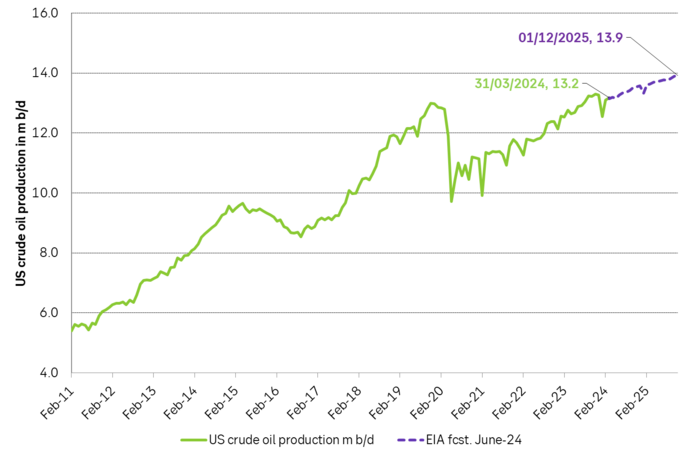
US EIA June STEO report with YoY outlook growth for 2025. Projects that US crude production will grow by 0.47 m b/d YoY in 2025 and that total liquids will grow by 720 k b/d YoY.
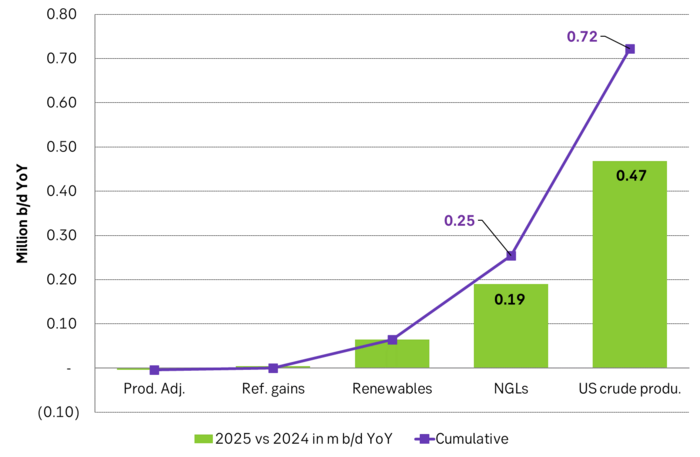
US EIA June STEO report with outlook for production growth by country in 2025. This shows how big the US production growth of 0.7 m b/d YoY really is compared to other producers around the world
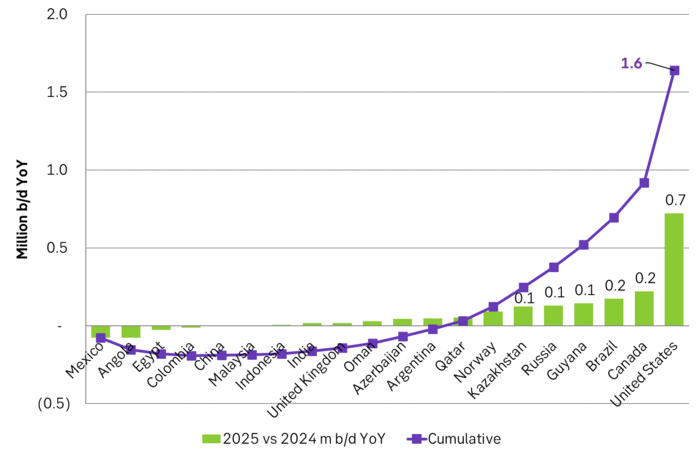
US EIA June STEO report with projected global growth in supply and demand YoY in 2025. Solid demand growth, but even strong supply growth with little room for OPEC+ to expand. Production growth by non-OPEC+ will basically cover global oil demand growth.
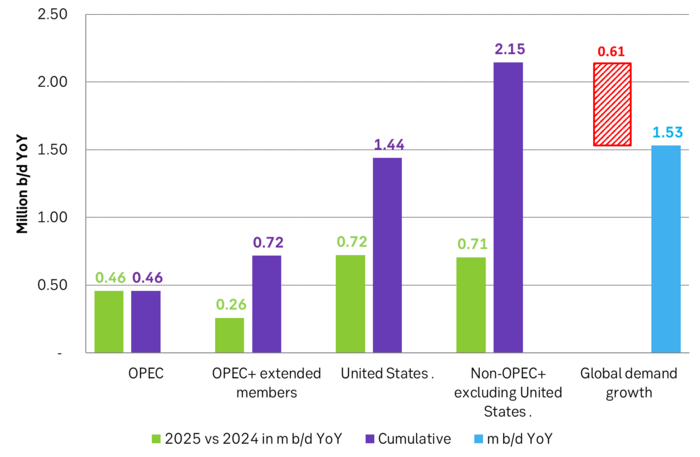
But if there instead is zero growth in US crude oil production in 2025 and the US liquids production only grows by 0.25 m b/d YoY due to NGLs and biofuels, then suddenly there is room for OPEC+ to put some of its current production cuts back into the market. Thus growth/no-growth in US shale oil production will be of huge importance for OPEC+ in 2025. If there is no growth in US shale oil then OPEC+ will have a much better position to control the oil price to where it wants it.
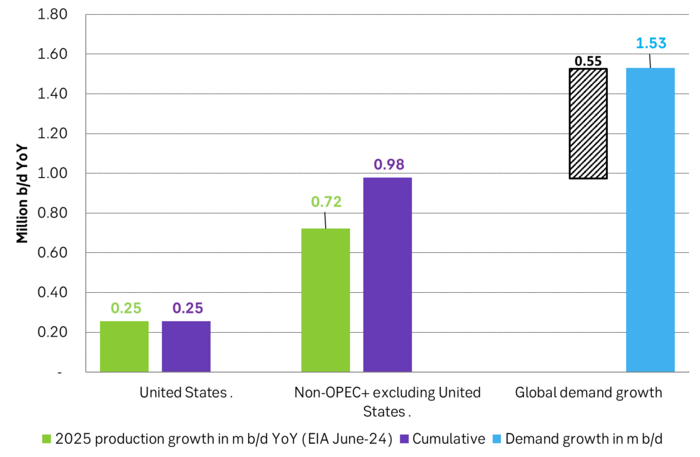
US crude oil production and drilling rig count
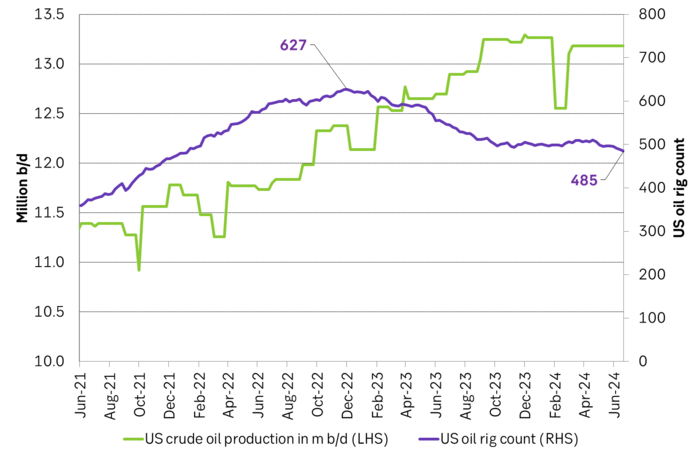
-

 Nyheter7 dagar sedan
Nyheter7 dagar sedanDe tre bästa råvaruvaruaktierna just nu
-

 Nyheter2 veckor sedan
Nyheter2 veckor sedanLundin Mining vill köpa Filo Corp tillsammans med BHP
-

 Nyheter4 veckor sedan
Nyheter4 veckor sedanAfrica Oil är bra att köpa anser Stifel som inleder analysbevakning
-
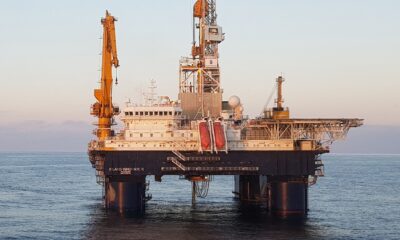
 Nyheter3 veckor sedan
Nyheter3 veckor sedanStor risk att Africa Energy inte överlever det kommande året
-

 Nyheter4 veckor sedan
Nyheter4 veckor sedanFirst Nordic Metals har fyra prospekteringsprojekt i Sverige
-

 Analys4 veckor sedan
Analys4 veckor sedanBrent crude inching higher on optimism that US inflationary pressures are fading
-

 Nyheter2 veckor sedan
Nyheter2 veckor sedanUniper satsar på att göra elektrobränsle av sin elektricitet
-

 Nyheter2 veckor sedan
Nyheter2 veckor sedanTre bra aktier inom olja och oljeservice i Kanada


